
|
Vol 70 |
Page 12 |
Privacy Policy | Editorial Policy | Profit Policy | Join the Association | List of Members | Contact us | Index | Links
Back Go to page: 1 2 3 4 5 6 7 8 9 10 11 12 13 14 15 16 17 18 19 20 Forward
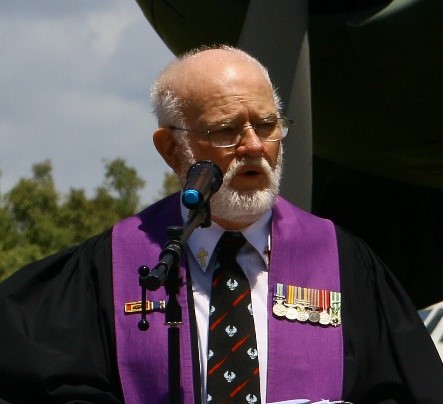
Arthur’s Articles.
On to Ballarat.
The night before we left Rathmines, all course members held an unofficial ceremony. I will explain one of the oddities of our time at Rathmines. The hotels in New South Wales closed at 6 p.m. daily and the drinking age in New South Wales was 18 years old, unlike Queensland where it was 21. As youths were able to join the Air Force at age 17, there had to be a local distinction in NSW whereby a 17-year-old could not enter a hotel bar while an 18-year-old could.
The powers that be had devised a remarkably simple method of recruits wearing a white tab on their epaulettes. 3 inches long and a half an inch wide would indicate an 18-year-old and over, while the 17-year-old recruit would wear a strip a quarter of an inch wide. The instruction was that these white strips would be sewn on to the epaulette. Some smart recruits found that white sticking plaster would do the same trick, so that they could leave the base in uniform, then rip off the sticking paster, replacing it before appearing in ‘drabs’ on the base on the next occasion they wore formal ‘drabs’ uniform.
I was away from the Rathmines Base one day in uniform, when I heard a fellow recruit being asked what did the white stripe represent? Bold-faced, he replied that he was a helicopter pilot.
The unofficial ceremony consisted of unpicking the white tabs and discarding them for ever.
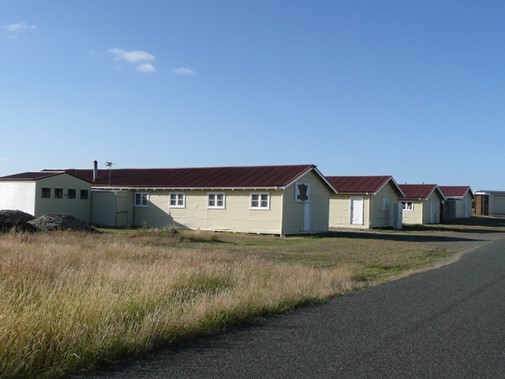
Course members spread to the four corners of Australia, some to never be seen again. Fred, who I had travelled down from Brisbane to Awaba with, and a fair gaggle of our course, headed off to Wagga Wagga to commence their technical training. The two Peters who had been with the PMG’s Department who also came down with Fred and me and one other who came in to the Air Force as a Surface Finisher as his brother had done some years before, boarded the Spirit of Progress for an overnight trip to Melbourne, again, not in a sleeper.
Accommodation Huts at RAAF Base, Ballarat.
After an uneventful trip, we arrived in Melbourne and hung around Spencer Street Station until the Overlander left that afternoon for Adelaide. We three were only going as far as Ballarat. We arrived at Ballarat Station about 5 p.m. that afternoon and as we disembarked from the Overlander, we were struck with the coldest blast that I had ever experienced. We stood there shivering until the RAAF truck arrived to convey us back to the Base.
Ballarat Air Base was a collection of old-World War Two huts which had been hastily established during the war to provide Wireless Air Gunners for duties throughout the war theatres. De-centralised Wireless Air Gunner schools had been brought into Ballarat in 1942 to complete this task. 1WAGS was the forerunner of Radio School which taught all radio associated trades, from aircrew Signallers to Tels Ops, Telegraphists, Sigs Ops, Telephone Ops, Radio Mechanics, Radio Technicians, Comms Ops and Comms technicians. If a job required training in the radio ops or repair field, that training was undertaken at RAAF Base Ballarat.
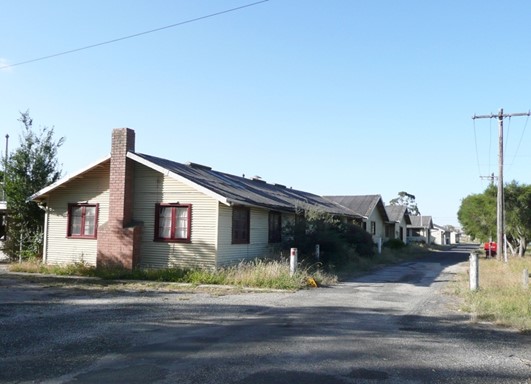
We were given our sleeping quarters that night, and at least, we escaped from the chilling blast of Antarctic wind that had welcomed us to Ballarat.
The following morning, we had to complete the usual rigmarole of being admitted to a new unit by walking all over the base to complete our inward clearances, but we did receive an impression of how large and spread out our new home really was.
Married Quarters at RAAF Base, Ballarat.
As with Rathmines, Day Three saw us attend the ‘Poolies Parade’. As our radio mechanic course was not due to start until the New Year of 1961, we had to occupy ourselves through the various tasks thrown at the ‘Poolies’. Along with five other ‘Poolies’, I was assigned to the Carpenter’s Shop. That suited me fine, as I had gone to East Brisbane State School during my primary school days at Camp Hill State School to do Manual Training, and I liked working in wood and in that environment. In fact, I saw it as a step up from the Officers’ Mess Kitchen and the Boiler rooms tasks I had as a ‘Poolie’ at Rathmines.
An AC Carpenter, Rod Dell, had recently completed recruit course and Ballarat was his first posting into the ‘real world’ of the RAAF. Every morning, Rod would take his five ‘Poolies’, eager to do a days’ carpentry, out into the back blocks of the Base where a golf hitting net had been created, ostensibly for the Commanding Officer, Wing Commander Fairbanks, to practice his golfing drives.

The ‘net’ consisted of chicken wire being strung between two disused telegraph poles, some thirty yards apart, with hessian affixed to the chicken wire. You’ll remember I had already noted the cold chills that greeted me in Ballarat, well, this practice net was strung up in the wide open space where the winds that blew across the Western Plains of a night, caused havoc to the hessian resulting in its total wreckage by morning. As we arrived each morning, the destruction from the night before would be evident and hessian flapped wildly in the wind from every section of the previous night’s wholesome work. Every day, we would climb ladders and re-affix the hessian to the chicken wire and by the end of the day, the golf net would be in excellent condition.
If only our golf net was 10 feet by 7 feet!
The following morning, we would be greeted with the hessian flapping in the wind and once again, we would brave the chilly elements to return the golf net to its immaculate wholesomeness.
This ritual lead me to saying in exasperation that when I get to Heaven when this life is done, I am going to seek out Wing Commander Fairbanks and ask him if he ever practised his golfing swing while he was at Ballarat. I have a dreadful feeling that Rod Dell and we five ‘Poolies’ were simply pawns in the ‘let us find something to keep these ‘Poolies’ occupied’ conspiracy!
Christmas arrived, and I took leave to return home to Brisbane. I never gave a thought to who would repair the Commanding Officer’s golf practice net each day over the Christmas break, and I guess he never had a chance to practice his golf swing.
On our return to Ballarat, our course started in earnest. We had to complete the theory phase before we split our class in two and some were arbitrarily channelled to the ‘Air’ phase while the others were channelled to the ‘Ground’ phase. We also saw several of our classmates fail a theory phase and were re-mustered to another suitable trade. Generally, those who failed before Phase 3, were immediately re-mustered to General Hand, while those who made it past Phase 3, had a choice. Some selected Telegraphist, and one selected Medical Orderly.
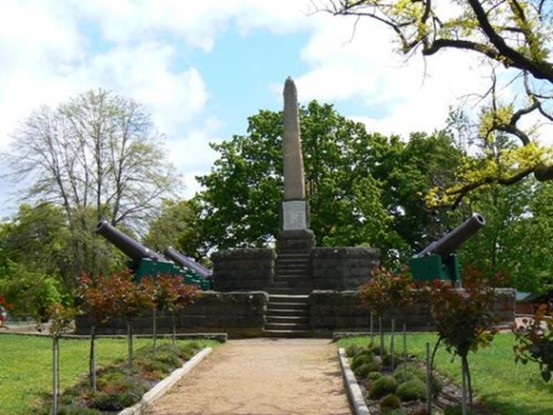
Ballarat was a beautiful town, and once school was over for the week, and we had some free time to ourselves. We managed to do a bit of sight-seeing, together. Ballarat was famous, or infamous, for the revolt by miners which culminated in the erection of a monument east of Ballarat at Eureka Stockade. This was a must for all visitors and dutifully, we trainee mechanics from School of Radio included the Eureka Stockade in our itinerary of local sight-seeing.
Eureka Stockade Monument.
When Melbourne hosted the Olympic Games in 1956, the rowing events were held in Ballarat at Lake Wendouree, which along with its Begonia House and Avenue of Australian Prime Ministers, was a ‘must see’ tourist attraction both in 1961 and later when my family and I were posted to Melbourne Units as well as very unit in Point Cook except for the Institute of Aviation Medicine in later years.
In those days, Ballarat still had trams, as did Bendigo. Gliding relatively silently through the main street of town, Sturt Street, they would slowly make their way out to the then far flung suburbs of Ballarat, such as Sebastopol. Sadly, there were no trams or any public transport that ran out to the RAAF Base some seven kilometres from the centre of Ballarat.
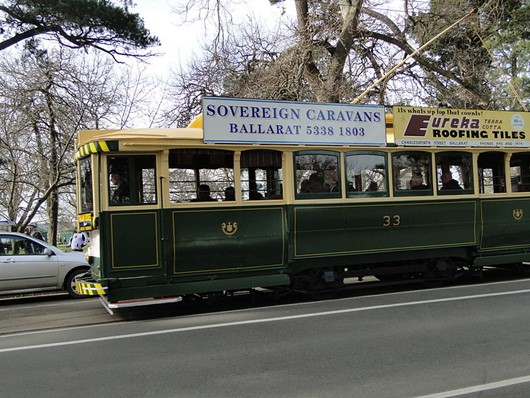
I remember one weekend walking the long walk from our living quarters down to the main gate in the hope of hitching a ride into town. As I walked with a classmate, David Kingsley King, who hailed from Tasmania, he said to me that he was committed to the long haul and had signed up for twelve years, whereas, unlike me, I showed no commitment to my new career in that I had only signed up for six years. I ignored his logic to prove himself more committed than me and continued walking. David did stay for the long haul, being commissioned as a Radio Officer some years later.
A Ballarat Tram of the 1960's
From my civilian days and you could say, since my childhood, Sunday was a day for attending church. Once I bought my ‘wheels’, a 1958 Morris Major sedan, I found my way to the nearest Baptist Church in Dawson Street. It was a magnificent example of Gothic architecture.
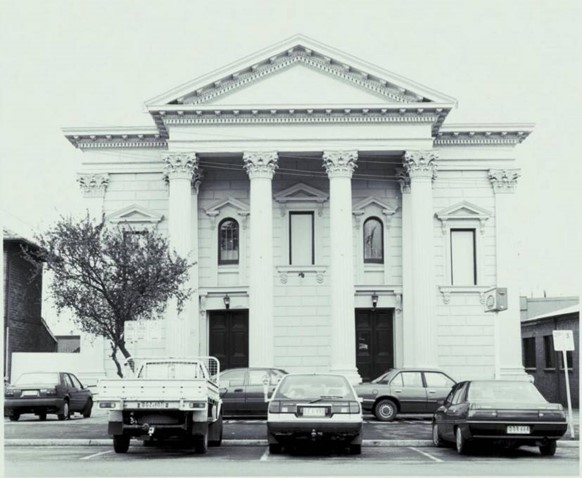
Sadly, sometime after I was stationed in Ballarat, the Baptist Church was sold, and the building became a restaurant and a night club before falling into disrepair. In 2009, the Victoria Heritage Society obtained the building and began painstakingly restoring it to its former glory. Of the once beautiful church buildings belonging to the Baptists, the Congregationalists, and the Methodists, that straddled the Dawson Street precinct, only St. Patrick’s Roman Catholic Church remains as a worship centre today.
Back in the 1960’s, many younger people including many trainees from the Radio School, attended “St. Pat’s “ on a Saturday night, not for a religious service but “St. Pat’s” held the largest and most successful dance in town.
Dawson Street Baptist Church, Ballarat.
I guess because of the evangelical background of my family, it was natural for me to invite friends I had made along to church. I invited one of my fellow trainees at Radio School to join me one evening. After the service, as we were leaving, the minister shook my friend’s hand vigorously and enquired of him, “Are you living by the Lord, Brother?” My friend, not understanding the question that laid behind his innocuous question, was put on the spot, and blurted out, “I suppose so!” The minister went into an ecclesiastical outburst of joy and exclaimed, “Hallelujah, Saints be praised. Hallelujah!” As we moved outside the church, my friend said to me, “What did he say?” I responded, “I’ll tell you when we get home!”
RAAF Base Ballarat had once been an airfield, known as the Ballarat Aerodrome, which boasted several runways. So well-kept were those runways that motor races were held there from the early 1950’s with the last race, the International Formula Libre race held in February 1961, which was attended by some European Formula One teams, BRM factory drivers Dan Gurney and Graham Hill. Bales of hay were placed all around the airfield to identify the course, as well as cushion the impact of any race cars that moved off the main race way.
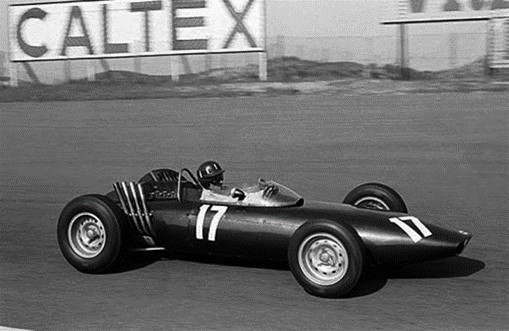
Crowds thronged into RAAF Base Ballarat for that last meeting. Several visitors availed themselves of the services provided by the Airmen’s ‘Boozer’, which was crowded after the racing finished for the day on the Saturday.
Many other visitors availed themselves of our amenities, including our ablution blocks. I remember about 7.00 p.m. that night, word went through the blocks that female visitors were availing themselves of our communal showers, all without dividing partitions. Rumour is that there was a sudden urge by trainees remaining on base to suddenly clean their teeth. The number trying to gather around the sinks and the length of time it took to clean their teeth, Radio School members must have had the whitest teeth on earth that night! (Sorry, no photos of that segment available!)
Several radio trainees pulled an extra guard duty that Saturday night, to protect the valuable machinery that was stored in one of the disused hangars. I pulled a midnight to 2.00 a.m. shift. I can remember my time on guard duty meant hanging around the front of the hangar that stored these racing cars. I thought how futile it would be if someone did attempt to enter the hangar as I did not even carry a truncheon! “Hey, you, put that racing car back where you found it,” is about all I could challenge a potential thief with.
Just at the end of my shift, I saw my friend coming down the road to the hangar, the friend who I had taken to church that time, so I walked away from the front of the hangar towards him. We chatted for a few minutes about how quiet it was. He took up his post and I returned to the guard house.
While my friend was on his shift, a mobile RAAF Police patrol came across a BRM pushed into some hay bales. Later, in the guard house, it was learned that some drunken visitors, (it would never have been Radio School students ??) after a night in the Airmen’s Boozer, decided to take a racing car for a spin around the circuit. They purloined a BRM, pushed it out of the hangar, (I believe it was Graham Hill’s BRM,) but when they could not get it started, they ditched it into a bale of hay.
The Service Police came into the guard room and said that if they had started the BRM, the culprits could have killed themselves. Inquisitive me had to ask, “What time do you think it was stolen?” The reply: “Somewhere between midnight and 2 a.m.” Oh dear, that means it was stolen right from under my nose!
The culprits were never caught, and Graham Hill and Dan Gurney raced on the Sunday without any further incidents. That night, we re-gained our ablution blocks; the Airman’s boozer returned to its normal occasional patrons and the last race day at Ballarat closed a very unusual chapter in the life at RAAF Base Ballarat.
Classes continued, several more classmates having failed the regular tests, were shown a different career path in the RAAF. When the theory phase had finished, the class was split into ‘Air’ and ‘Ground’ subjects, one concentrating on equipment found in all types of aircraft and the other ground, which concentrated on all types of equipment found at Base Radio Sections. I was appointed to the ‘Air’ group while my mate who had accompanied me, once, to church, was put into the ‘ground’ class.
In mid-March, the announcement was made that the whole School was to move to Laverton. (It was then I found out that my information giver at the Brisbane Recruiting Centre was totally wrong, and that Laverton was not in Western Australia, but just outside Melbourne alongside the Melbourne to Geelong Highway.)
Classes ceased, and all trainees were allotted to cleaning up, packing up and other tasks related to the big move. Concurrent with this announcement was one that told us that the RAAF was going to have a farewell parade to the City of Ballarat as well as provide a farewell concert by the RAAF Central Band to say goodbye to the citizens of Ballarat at the Civic Hall.
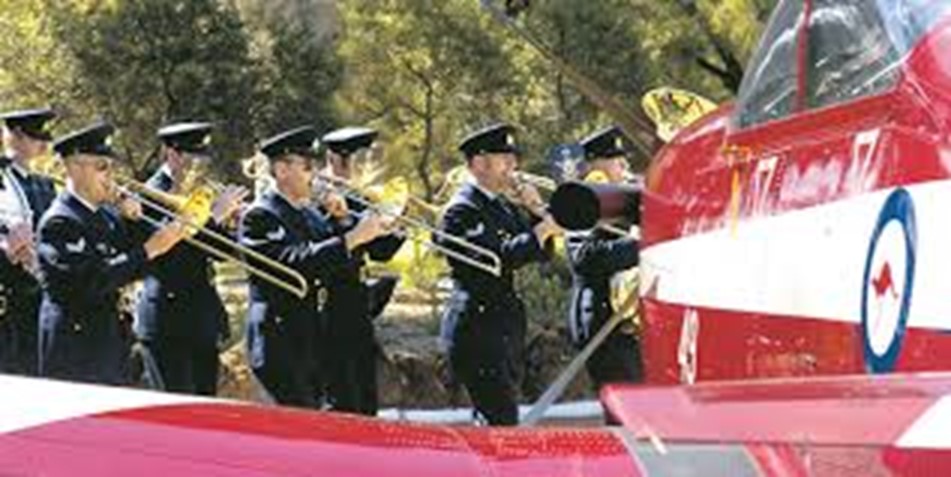
A call was made for those who had a singing voice to volunteer for the choir that would perform in this farewell tribute alongside the RAAF Central Band. There was a student on a course earlier than mine, Errol Kiely, who had sung with me in the Camp Hill State School Choir. In fact, in 1954, Errol was chosen to conduct the Junior Boys’ Choir at an Eisteddfod in Brisbane. I was chosen as his under-study in case he could not fulfil the position on the day, but I did have to take my turn in swinging the baton just in case. In the event, Errol kept well, and my claim to fame is that I sang in that Junior Boys’ Choir and to everyone’s surprise, Camp Hill Junior Boys’ Choir won!
Errol approached me and invited me to join him as he volunteered for this special event choir. We had both been soloists in the Camp Hill Choir and although a bit reluctant to join him, he espoused the benefits of singing and practicing in this special choir, rather than participate in the cleaning up and preparation to move the entire school to Laverton. Once I caught a glimpse of the perks that were on offer, I gladly let my name go forward.
We would be taken into the Civic Hall for days before the event. Usually about twice a day, we would gather with the RAAF Central Band and sing this piece that had been written especially for us to say thank you and farewell to the citizens of Ballarat. As I wrote this, I found a photo that was taken of the members of the RAAF Central Band relaxing at the back of the Civic Centre, which the Ballarat Courier published in the newspaper of the day.
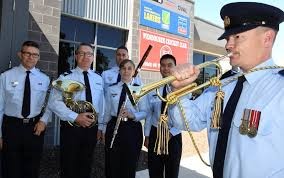
To sing with the RAAF Central band was a great honour, but to dodge all the work needed to leave the base in a presentable condition for hand-over, was a perk that I really enjoyed and was ever so pleased that I had put my vocal services to the good of the RAAF and the RAAF Central Band by volunteering to sing their Farewell Song, which with the passage of time, I cannot remember a word!
Actual Photo Taken by The Ballarat Courier
Finally, the big day came, the Civic Farewell was behind us, the multiple ‘thank you’ from the crowds both to the RAAF Central Band and to our small group of choristers were slowly fading from our ears. Now it was time to slip back into the real Air Force and climb into our finest parade gear and participate in the final event of the Unit’s long association with the City of Ballarat, the Farewell Parade.
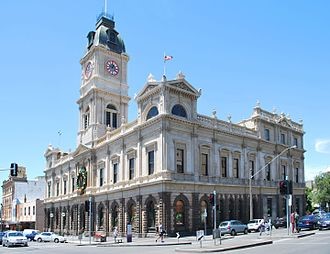
I remember standing at attention for a remarkably long time, and something took my fancy. We were on parade in front of the Ballarat town hall, when I looked up and noticed that Ballarat was spelt, “B-A-L-L-A-A-R-A-T”. (later, in life, I learnt that Ararat was also spelt with four ‘a’s in the spelling. To beat the boredom of that long parade, I conjured up in my mind that with this privileged information, I could no doubt make a few extra shillings when I asked people to spell ‘Ballarat’. The time I spent on the farewell parade was not in vain at all. I learned how to spell ‘Ballarat’. That information could come in very handy one day!
The Ballaarat Town Hall
Finally, with all goodbyes and farewells completed for the end of the RAAF era in Ballarat, those with motor cars piled into them ostensibly to drive in convoy down to Laverton. Others clambered aboard busses with all their worldly goods and chattels, and they were driven down to Laverton.
Radio School was moving out of Ballarat, holus bolus and heading for the next chapter in the life of the School of Radio and to my next posting, and another great adventure in the Air Force of the early 1960’s.
It was with a reasonable amount of fear and trepidation that I undertook this move for my track record had not been good. My first posting, to No. 1 Recruit Training Unit had seen my course participate in the final pass-out parade at Rathmines which was then closed as a RAAF Base. I had moved on to RAAF Base Ballarat, and there too, Ballarat Base had closed its doors while I was there. It must be me! Surely RAAF Base Laverton will not wither into the wilderness because of my presence. We will have to wait and see, so until next edition, you will have to wait and see what ill-fortunate spells I cast on RAAF Base, Laverton. Will it survive? Stay tuned.
People who impressed me in my Service Career.
A slight change in the title of this segment for this month. This quarter, I would like to tell the yarn about one of my classmates on 27 Radio Mechanics Course which began at Ballarat in January 1961. I would have liked to speak with this guy before I wrote about him, but as I haven’t been in contact with him for fifty-five years, I’ll just use his Christian name, to ‘protect the innocent’, as they say.
He was a great guy, full of fun and a friend to everyone that met him. He lived not far from me in Windsor, Brisbane, although I never knew him until we met at Ballarat. I will call him John, by which name he can identify. After his six years in the Air Force, he took his discharge and when we were last in contact, he was manning a remote radio station in the outback.
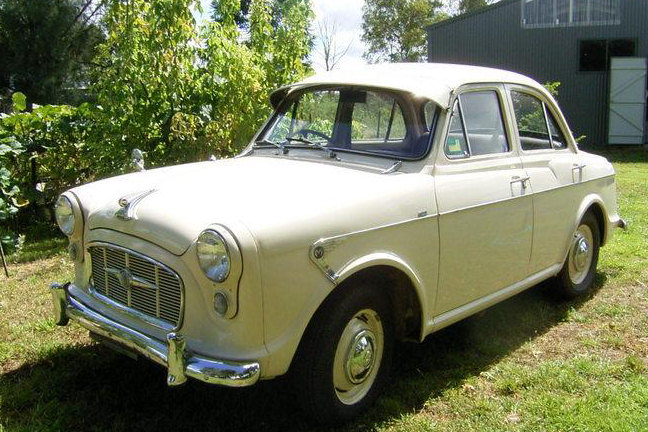
While at Ballarat, I went to Melbourne one weekend and bought myself a two-year-old Morris Major Mark One Sedan. The Air Base being seven kilometres from the centre of Ballarat town and not serviced by public transport, we trainees had to rely on hitching rides into Ballarat, and most times, we had to rely on taxis to bring us back to the base.
1958 Morris Major Mark 1 Sedan.
John was among the friends from my course I often took with me in the Major. On arrival in Laverton in the April of 1961, John decided to launch out and buy himself a car. He went into Melbourne and bought a very well kept, well immaculate, really, 1938 Chevrolet Fleet Master sedan.
After class on Friday afternoon, John drove his Chevy into Melbourne with great pride. Unfortunately, while driving along Footscray Road, the Chevy developed a serious knocking sound, emanating from the engine bay. He made his way back to Laverton and returned with overalls, some tools, and an oil pan. He removed the oil, then the oil pan. He discovered that a conrod was broken; he removed the con rod and piston. He replaced the oil pan; poured the oil back in and started the engine.
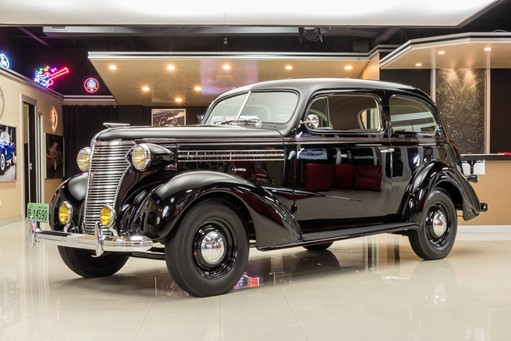
He reckoned that five cylinders should work as efficiently as six and drove his immaculate Chevrolet sedan to the nearest used car dealer. “It’s a beautiful looking machine,” the salesman said, “Do you have any problems with it?”
John responded, “Ah well, it’s missing a bit.” To which the salesman replied, “No worries, Mate, we’ll soon tune that up!” They made a deal. John collected his cash and did not lose one penny on the deal.
1938 Chevrolet FleetMaster Sedan.
That was the day that I learned that it is not what you say, but how you say it. John never told an untruth, but the salesman missed his statement by a mile and ‘assumed’ that he was talking about the engine misfiring. What John meant, was that the engine was missing a part, an important part, – a conrod and piston!
This double talk occurred again when four of us, all Radio Mechanics, went on our first posting, to Amberley. We hung out together and one night, we found ourselves where all young people in Ipswich and district seemed to congregate, the Palais Royal Hotel on the corner of Brisbane Road and East Street.
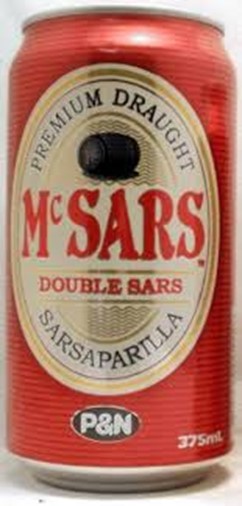
In those days, the drinking age in an hotel in Queensland was twenty-one. The four of us had ordered our ‘Double Sars’ (Sarsaparilla,) as that was our preferred drink of choice. (Being recently graduated Radio Mechanics, we had to keep a clear head for our work concentration on Air Force radio equipment the next morning! – If you believe that, read on!)
Two burly policemen came into the Palais Royal and demanded of the first of our group, “How old are you?” He spluttered, “Twenty.” The policeman sternly ordered, “Out!” He turned to our second under twenty-one-year old and demanded, “How old are you?” To which came the reply, “Twenty”. Same directive, “Out!” then he turned to John. “How old are you?” Word twister John, replied, “Twenty (pause) too!” The cop said, “You are OK.”
Then turned to me and hoping to ride on John’s back, said, “Same as him!” The policeman replied, “OK, you two can stay but you two,” pointing to the first two who admitted to being only 20, the cop said very brusquely, “Out!” You would think that as none of us received more than a friendly warning, that I would have left it at that, but no, I bounced up and said, “If they can’t stay then I am not staying without them ,” and led my three mates out of that bar as fast as we could.
How could John be blamed if the policeman mistook his answer of ‘Twenty (pause) too,” when the policeman heard, “Twenty (pause) two?”
In my next twenty-five plus years, I was to see many other examples of double-talk by clever military personnel. I will give John his due, he was the Grand Master of the skill.
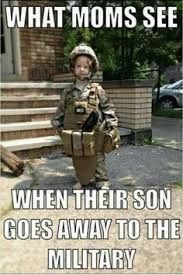
Back Go to page: 1 2 3 4 5 6 7 8 9 10 11 12 13 14 15 16 17 18 19 20 Forward